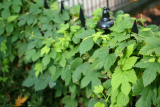Additional notes (click to expand)
Horticulture
Rhizomatous, twining perennial with roughly hairy shoots and deeply 3-to 5-lobed, coarsely toothed, light green leaves, to 15cm long. Small male and female flowers are borne on separate plants in mid-to late summer: the males in axillary panicles, the females in cone-like spikes. The female inflorescences are ovoid, fragrant, green then straw-coloured and used brewing. It can grow to 6 metres high.
Brickell, C. (2003). A-Z Encyclopedia of Garden Plants. Dorling Kindersley. p.550
Grow in moist but well-drained, moderately fertile, humus-rich soil in sun or partial shade. To propagate, sow seed at 15-18°C in spring. Root softwood cuttings in spring or greenwood and leaf-bud cuttings with bottom heat in summer. Susceptible to Verticillium wilt.
Brickell, C. (2003). A-Z Encyclopedia of Garden Plants. Dorling Kindersley. p.550
Medicinal
Culpepper’s view on hops was that a “decoction of the tops cleanses the blood, cures the venereal disease, and all kinds of scabs, itch, and other breakings out of the body; as also tetters, ringworms, spreading sores, the morphew, and all discolourings of the skin”.
Bird, R, Houdret, J. (2000). Kitchen and Herb Gardener. Lorenz. p.394
The dried, female flowers are said to have sedative properties. Historically, it has been taken internally in infusions or tinctures for insomnia, nervous tension and anxiety. The dried flowers have been applied externally for skin complaints.
Traditional Herbal Medicine Registration (THMR).
Medicinal uses
Uses supported by clinical data
None.
Uses described in pharmacopoeias and well established documents
As a sedative for the treatment of nervous tension and insomnia. Treatment
of dyspepsia and lack of appetite (5, 15–17).
Uses described in traditional medicine
Treatment of abdominal cramps, anaemia, bacterial infections, dermatitis,
diarrhoea, dysmenorrhoea, leukorrhoea, migraine and oedema (6). As an
analgesic, anthelminthic, antipyretic, aphrodisiac, carminative, depurative,
digestant, diuretic, diaphoretic and tonic (6).
Contraindications
Strobilus Lupuli is contraindicated in cases of known allergy to the plant
material.
WHO Monographs on Selected Medicinal Plants. Volume 3. 2007. WHO, Geneva
Nomenclature
The English name, hop, comes from the Anglo-Saxon hoppan (to climb).
Grieve, Mrs M. (1931). A Modern Herbal, Penguin. Leyel, Mrs CF p.411
Hu’mulus is a Medieval name apparently Latinized from a Low German or Slav name for the word hop. There are two species widely grown commercially- H. americanus and H. lupulus (The European hop).
Stearn, W.T. (1996). Dictionary of Plant Names for Gardeners. Cassell. p.169
lupulus, literally means a "small wolf." This is in reference to the plant's habit of climbing over and smothering trees.
Stearn, W.T. (1996). Dictionary of Plant Names for Gardeners. Cassell. p.169
Other use
The hop cones of the female plant of the common hop species, Humulus lupulus, are grown almost exclusively for the brewing industry. Only the cones of the female plants are able to secrete the fine yellow resinous powder (i.e. lupulin glands). It is in these lupulin glands that the main brewing principles of hops, the resins and essential oils, are synthesized and accumulated. Hops are of interest to the brewer since they impart the typical bitter taste and aroma to beer and are responsible for the perceived hop character. In addition to the comfortable bitterness and the refreshing hoppy aroma delivered by hops, the hop acids also contribute to the overall microbial stability of beer. Another benefit of the hop resins is that they help enhance and stabilize beer foam and promote foam lacing.
Almaguer, C., Schönberger, C., Gastl, M., Arendt, E. K., Becker, T. (2014). Humulus lupulus – a story that begs to be told. A review. Wiley Online Library. http://onlinelibrary.wiley.com/doi/10.1002/jib.160/abstract
link
The Romans used to eat the young shoots like a vegetable, as did country folk in Britain into the 20th century.
Bird, R, Houdret, J. (2000). Kitchen and Herb Gardener. Lorenz. p.394
Dried flowers are added to sleep pillows and distilled oil (from the flowers) used in perfumes. Active principles are thought to help prevent ageing of skin and brittleness of hair.
Bird, R, Houdret, J. (2000). Kitchen and Herb Gardener. Lorenz. p.394
Toxicity
Skin contact with the plant can cause dermatitis. Dislodged hairs from the plant can irritate the eyes. Avoid during pregnancy (due to antispasmodic action on uterus). Avoid with breast, uterine and cervical cancers. It has been widely thought that its sedative effect may worsen depression.
Geographical distribution
- Africa, Northern Africa, Morocco
- Asia-Temperate, Caucasus, North Caucasus
- Asia-Temperate, Caucasus, Transcaucasus
- Asia-Temperate, China
- Asia-Temperate, Eastern Asia, Japan
- Asia-Temperate, Middle Asia, Kyrgyzstan
- Asia-Temperate, Russian Far East
- Asia-Temperate, Western Asia, Lebanon-Syria
- Asia-Temperate, Western Asia, Turkey
- Europe, Eastern Europe, Belarus
- Europe, Eastern Europe, Northwest European Russia
- Europe, Eastern Europe, Ukraine
- Europe, Middle Europe, Austria
- Europe, Middle Europe, Belgium
- Europe, Middle Europe, Czech Republic
- Europe, Middle Europe, Hungary
- Europe, Middle Europe, Netherlands
- Europe, Middle Europe, Poland
- Europe, Middle Europe, Switzerland
- Europe, Northern Europe, Denmark
- Europe, Northern Europe, Finland
- Europe, Northern Europe, Great Britain
- Europe, Northern Europe, Norway
- Europe, Northern Europe, Sweden
- Europe, Southeastern Europe, Albania
- Europe, Southeastern Europe, Bulgaria
- Europe, Southeastern Europe, Greece
- Europe, Southeastern Europe, Italy
- Europe, Southeastern Europe, Romania
- Europe, Southeastern Europe, Yugoslavia
- Europe, Southwestern Europe, France
- Europe, Southwestern Europe, Portugal
- Europe, Southwestern Europe, Spain
- Northern America, Eastern Canada
- Northern America, Mexico, Mexico Northeast
- Northern America, Mexico, Mexico Northwest
- Northern America, North-Central U.S.A.
- Northern America, Northeastern U.S.A.
- Northern America, Northwestern U.S.A.
- Northern America, South-Central U.S.A.
- Northern America, Southeastern U.S.A.
- Northern America, Western Canada
Podcast
Humulus lupulus L.
Family: CANNABACEAEGenus: Humulus
Species: lupulus L.
Common names: Common hop
Pharmacopoeia Londinensis name: Lupulus
Distribution summary: N. Africa, Asia, Europe, N. America
Conservation status (IUCN Red List): Least Concern
Habit: Climber
Hardiness: H5 - Hardy; cold winter
Habitat: Woodlands
Garden status: Not currently grown
Flowering months: June, July, August
Reason for growing: Medicinal, other use, traditional herbal registration

.JPG)
.JPG)
.JPG)
.JPG)